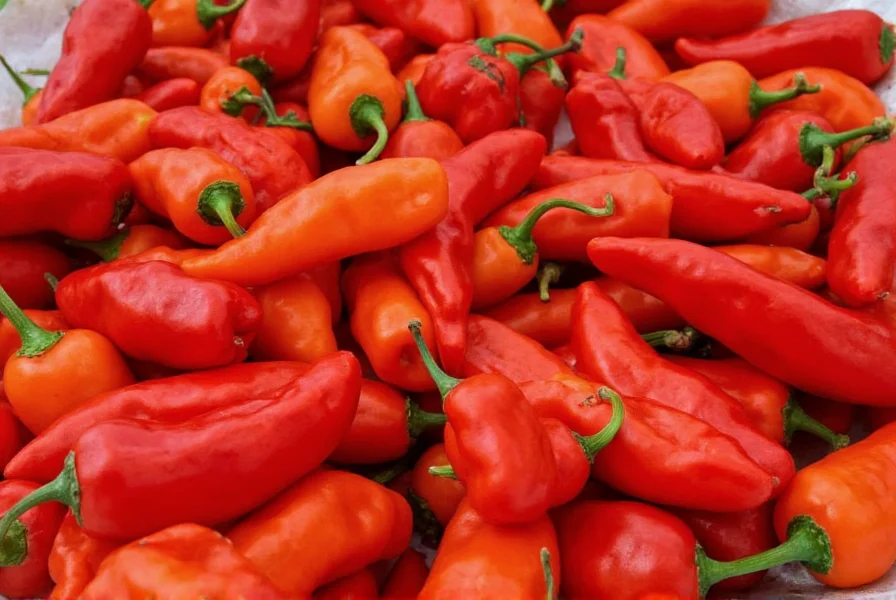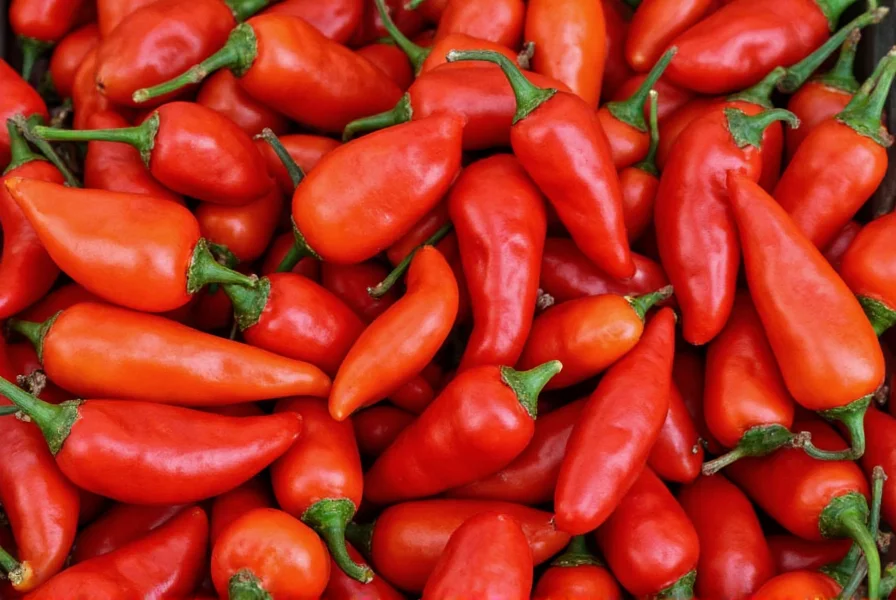For chili enthusiasts and culinary explorers alike, understanding the true origin of the ghost pepper provides valuable context for appreciating this extraordinary ingredient. The Bhut Jolokia isn't just another hot pepper—it represents centuries of agricultural tradition in one of the world's most biodiverse regions.
The Scientific Identity of Ghost Peppers
Botanically classified as Capsicum chinense 'Bhut Jolokia', ghost peppers belong to the same species as other super-hot chilies like the Scotch bonnet and habanero. Despite the "chinense" designation suggesting Chinese origin, this species actually evolved in the Americas before spreading globally through trade routes.
What distinguishes ghost peppers from other varieties is their extraordinary heat level, measuring between 855,000 and 1,041,427 Scoville Heat Units (SHU). To put this in perspective, they're approximately 200-400 times hotter than a typical jalapeño pepper.
Historical Roots in Northeast India
The ghost pepper's story begins in the remote northeastern region of India, where it has been an integral part of local cuisine and traditional medicine for generations. The name "Bhut Jolokia" translates to "ghost chili" in Assamese, reflecting how its intense heat seems to sneak up on you like a ghost.
Indigenous communities in Assam, Nagaland, and Manipur have cultivated these peppers for at least several hundred years. Local farmers developed specific growing techniques suited to the region's humid subtropical climate and fertile alluvial soils. The peppers became so culturally significant that they were incorporated into traditional dishes, religious ceremonies, and even used as a natural pest deterrent.
| Ghost Pepper Characteristics | Details |
|---|---|
| Scientific Name | Capsicum chinense 'Bhut Jolokia' |
| Origin Region | Northeast India (Assam, Nagaland, Manipur) |
| Heat Level (SHU) | 855,000-1,041,427 |
| Physical Appearance | Wrinkled, tapered shape; red, orange, or yellow when ripe |
| Traditional Uses | Culinary spice, medicine, elephant deterrent |
Geographical Significance of the Northeast Indian Region
The specific microclimate of Northeast India creates ideal growing conditions for ghost peppers. The region features:
- High humidity levels (70-90% during growing season)
- Moderate temperatures (25-32°C / 77-90°F)
- Rich, well-drained alluvial soils from Himalayan river systems
- Distinct wet and dry seasons that influence pepper development
This unique combination of environmental factors contributes to the ghost pepper's exceptional heat and flavor profile. The region's biodiversity also means ghost peppers grow alongside numerous other native plant species, creating a complex ecological relationship that influences their development.
Cultural Importance in Indigenous Communities
For the indigenous peoples of Northeast India, ghost peppers are far more than just a spicy ingredient. They serve multiple important functions:
In traditional Assamese cuisine, ghost peppers are used sparingly to add intense heat to dishes like masor tenga (sour fish curry) and various meat preparations. The Naga tribes incorporate them into their signature dish nakham bura (fermented soybean with chili).
Perhaps most fascinating is their use as an elephant deterrent. Villagers in Assam traditionally smear ghost pepper paste on fences or create smoke bombs from dried peppers to keep elephants from raiding crops—a practice that has gained attention from conservationists worldwide.

Global Recognition and Spread
While ghost peppers have been cultivated in Northeast India for centuries, they gained international recognition relatively recently. In 2007, the Bhut Jolokia was certified by Guinness World Records as the world's hottest chili pepper, a title it held until 2011.
This recognition sparked global interest in the pepper, leading to:
- Increased cultivation in other parts of India and worldwide
- Scientific studies examining its heat properties and potential medical applications
- Commercialization for hot sauces, spice blends, and even non-food products
Despite this global spread, authentic Northeast Indian ghost peppers maintain distinctive characteristics due to the specific terroir of their native region. Many chili enthusiasts argue that ghost peppers grown outside their native habitat lack the complex flavor profile of those cultivated in Assam, Nagaland, and Manipur.
Modern Cultivation Practices
Today, ghost peppers are cultivated in various parts of the world, but understanding their origin helps growers replicate optimal conditions. Successful cultivation requires:
- Long growing season (150-180 days)
- Consistent warmth and humidity
- Well-draining soil with moderate fertility
- Protection from extreme weather conditions
In their native Northeast India, farmers continue traditional cultivation methods passed down through generations. These techniques have proven remarkably effective at producing peppers with consistent heat levels and flavor profiles.

Ghost Peppers in Contemporary Cuisine
While ghost peppers originated in Northeast Indian cuisine, they've now become a global phenomenon. Chefs worldwide incorporate them into dishes seeking extreme heat, though typically in very small quantities due to their intensity.
Understanding where ghost peppers come from helps culinary professionals appreciate their proper usage. Traditional Northeast Indian cooking demonstrates how to balance this extreme heat with other flavors—a lesson that modern chefs continue to learn from the pepper's place of origin.
Frequently Asked Questions
Are ghost peppers originally from India or Bangladesh?
Ghost peppers are native to Northeast India, specifically the states of Assam, Nagaland, and Manipur. While they're also grown in neighboring Bangladesh and parts of Bhutan, their historical cultivation and traditional use center on Northeast India. The pepper has been part of indigenous Assamese and Naga culture for centuries before modern political boundaries were established.
How did ghost peppers get their name?
The name "ghost pepper" comes from the Assamese term "Bhut Jolokia," which translates to "ghost chili." This name reflects how the pepper's intense heat seems to sneak up on you unexpectedly, like a ghost. In Northeast India, people believe the heat is so powerful it must have supernatural origins, hence the ghost association.
Why are ghost peppers so much hotter than other chilies?
Ghost peppers' extreme heat results from their specific genetic makeup combined with the unique growing conditions of Northeast India. The region's high humidity, specific soil composition, and temperature patterns contribute to higher capsaicinoid production—the compounds responsible for chili heat. Centuries of selective breeding by indigenous farmers have also favored plants with higher heat levels for various practical applications.
Can ghost peppers be grown outside their native region?
Yes, ghost peppers can be grown outside Northeast India, but they often develop different characteristics. While they'll still be extremely hot, peppers grown in different climates may have slightly different flavor profiles and heat levels. Successful cultivation requires replicating the warm, humid conditions of their native region. Many growers outside India find they need to provide additional humidity and consistent warmth throughout the long growing season.
What's the difference between ghost peppers and other super-hot chilies?
While all super-hot chilies belong to the Capsicum chinense species, ghost peppers have a distinctive flavor profile beyond just heat. Compared to peppers like the Carolina Reaper or Trinidad Moruga Scorpion, ghost peppers offer a more complex flavor with subtle smoky and fruity notes before the intense heat hits. Their heat also builds more gradually and lasts longer than many other super-hots. This unique combination of flavor and heat pattern is directly tied to their Northeast Indian origin and traditional cultivation methods.










 浙公网安备
33010002000092号
浙公网安备
33010002000092号 浙B2-20120091-4
浙B2-20120091-4